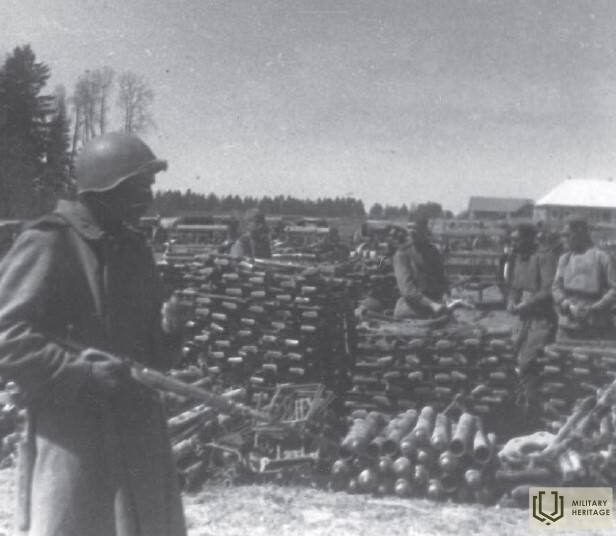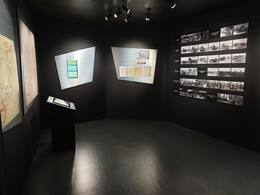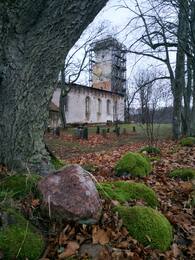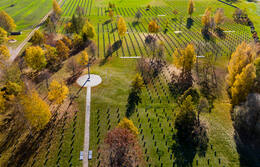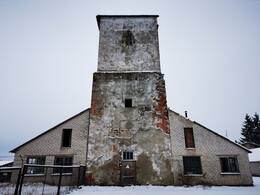Ezeroje kilusio Jānio Miesnieko prisiminimai apie Antrojo pasaulinio karo pabaigą Ezeroje
Ezerės kultūros istorijos ir kraštotyros muziejus „Muitinė“ įsikūręs istoriškai reikšmingame pastate. 1945 m. gegužės 8 d. čia buvo pasirašytas Kuržemės fronte apsuptų nacistinės Vokietijos armijos dalinių kapituliacijos aktas.
Buvęs Ezeras gyventojas Jānis Miesnieks (gim. 1930 m.) dalijasi prisiminimais apie tos dienos įvykius.
Atėjo 1945 metų pavasaris, ir fronto linija jau buvo netoli Saldaus. Visi kaimynai taip pat grįžo iš priverstinės evakuacijos į Lietuvą. Likimo valia tapau svarbaus istorinio įvykio liudininku. Vieną gegužės dieną jaunas vyras iš Mažeikių atvyko atsiimti atlyginimo už vasarą atliktą darbą. Atitinkamus grūdų maišus krovėme į arklių traukiamą vežimą, kurį tempė sena, labai patyrusi kumelė Irma. Judėti buvo galima tik labai siaura kelio puse, nes viduryje buvo gili, purvina vaga, kuria važiavo sunki technika. Jau buvo popietė, kai iš „Zakių“ išvykome į Ezerius. Judėjimo greitis galėjo būti apie 3 km per valandą. Tačiau kariuomenės kelių patrulis neleido mums kirsti Vadakstės tilto Ezeruose į Mažeikius. Kitas tiltas per Vadakstę buvo ties Laižuva ir vietoj 13 km kelias iki tikslo tapo 33 km ilgio. Po kelių kilometrų, tarsi fantomai iš kitos dimensijos, keli puikūs juodi limuzinai lėtai pajudėjo mūsų link šiuo apgriuvusiu keliu. Aiškiai matėme kabinoje sėdinčius žmones – aukšto rango Raudonosios armijos vadus, bet pačiame gale sėdėjo vokiečių karininkas su būdingomis aukštomis uniforminėmis kepurėmis. Pakeliui girdėjome ir gana garsius triukšmus iš fronto. Tačiau kai kelią užklupo naktis, visa fronto linija liepsnojo ugnimi, raketinis saliutas, spindinčių kulkų pėdsakai dangaus pakraštį papuošė tarsi karoliukų vėriniai. Gražu, nors ir be kraujo kainos. Buvo akivaizdu, kad pragariškas pragaras mano Kuržemės regione pradėjo nevaldomai virti... Kuo temsta, tuo intensyviau priekiniai žibintai apšviečia pakraštį.
Mažeikius pasiekėme saulėtekio metu. Kuklus namelis pakraštyje, pasirodo, buvo galutinis mūsų ilgos, įdėtos nemažai pastangų ir kupinos įdomių įvykių kelionės tikslas. Čia buvo iškrautas krovinys, ir mes gavome, regis, nesuprantamą žinią: karas baigėsi!!! Vakar, gegužės 8 d., vokiečiai Ezerėje pasirašė kapituliacijos aktą.
Ištuštintu vežimu, snūduriuodamas iš išsekimo, tuojau pat patraukiau tiesiai per ežerą namo. Nepraėjus nė parai, situacija pasaulyje kardinaliai pasikeitė: kai vakar išvykau iš namų, vis dar buvo karo padėtis, bet gegužės 9-osios rytą įsivyravo taika. Ežere, už Vadakstės tilto, pravažiavau buvusią muitinę, kur vakar įgalioti Vermachto atstovai pasirašė Kuržemės apsupties fronto armijų besąlyginio kapituliacijos aktą. Būtent dėl šios priežasties vakar kelias per tiltą buvo uždarytas, o likimas man suteikė galimybę pamatyti įvykio dalyvius ir emocijų antplūdį fronte pirmąją taikos naktį. Tuo Kuržemės katile pragariškas troškinys nustojo virti. Kai gegužės 9-osios rytą grįžau į „Zakius“, mūsų namuose gyvenantys armijos ryšių karininkai buvo apimti tikros panikos...
Susijusi laiko juosta
Susijusios vietos
Ezerės kraštotyros saugykla „Muitas Nams“
Ezerės muitinė yra Ezerėje, netoli Saldaus-Mažeikių plento, Latvijos ir Lietuvos pasienyje. 1945 m. gegužės 8 d. šiame pastate buvo pasirašytas vadinamojoje „Kuršo kišenėje“ apsuptų Vokietijos armijos dalinių „Kurzeme“ (Kurlandas) kapituliacijos aktas. Manoma, kad Antrasis pasaulinis karas iš tikrųjų baigėsi Ezerėje. Muitinėje yra ekspozicija, kurioje aprašomi Antrojo pasaulinio karo pabaigos įvykiai, ir eksponatai, kuriuose išsamiai aprašoma Ezerės parapijos istorija nuo seniausių laikų iki šių dienų. 1945 m. gegužės 7 d. rytą Leningrado fronto vadas maršalas L. Govorovas išsiuntė armijų grupės „Kurzeme“ vadovybei ultimatumą sudėti ginklus. Kapituliacijos aktą susijusios šalys pasirašė gegužės 8 d., jame išsamiai aprašyta perdavimo tvarka, ginklų surinkimo punktai, pateiktini dokumentai ir informacija bei kitos praktinės priemonės.
Raudonosios armijos kalinių filtracijos stovykla Griezėje ir Griezės bažnyčia
Griežė yra Latvijos ir Lietuvos pasienyje, kur Vadakstės upė įteka į Ventą. Griežės bažnyčia buvo pastatyta 1580 m., tačiau parapija egzistavo dar iki 1567 m. Bažnyčia buvo kelis kartus perstatyta – 1769 m., 1845 m., o 1773 m. buvo įrengti pirmieji vargonai. Dėl įvairių priežasčių prarastas ir altorius, ir du varpai.
Bažnyčios sode yra kapinės, kuriose palaidoti bažnyčiai priklausę žmonės ir didikai. Vienas iš jų – „Grieze“ vargonininkas Friedrichas Barisas ir jo žmona Šarlotė, kuriems priešais bažnyčios zakristiją pastatytas paminklas. Pietinėje bažnyčios pusėje palaidoti 32 švedų kareiviai, žuvę Didžiajame Šiaurės kare. Kapinėse taip pat yra 110 vokiečių kareivių, žuvusių Pirmajame pasauliniame kare, kapai, kuriems 1930 m. pastatytas paminklas.
Antrojo pasaulinio karo metu bažnyčia nukentėjo, kai 1944 m. spalio pabaigoje fronto linija buvo ištempta palei Ventos upę, o Griezės bažnyčios apylinkėse buvo dislokuota vokiečių 225-oji pėstininkų divizija. Kai 1944 m. lapkričio 19 d. sovietų 4-oji smogiamoji armija pradėjo atakas per Ventos upę, keli artilerijos sviediniai pataikė į bažnyčios pietinę sieną, o bažnyčios bokštas buvo smarkiai apgadintas.
Po armijų grupės „Kurzeme“ kapituliacijos Raudonosios armijos Leningrado fronte į nelaisvę pateko 284 171 žmogus. 7493 buvo Raudonosios armijos kareiviai, paleisti iš vokiečių nelaisvės. Į nelaisvę pasidavė 48 vokiečių generolai. Remiantis armijų grupės „Kurzeme“ kapituliacijos metu pateiktais dokumentais, kareivių skaičius buvo apie 185 000. Likę iš beveik 100 000 filtruotinų žmonių buvo Kuržemės civiliai gyventojai ir sovietiniai pabėgėliai, nes 1945 m. gegužės 10 d. Sovietų Sąjungos Leningrado frontas įsakė filtruoti visus vyrus nuo 16 iki 60 metų amžiaus.
Raudonojoje armijoje, skirtingai nei kitų šalių ginkluotosiose pajėgose, karo belaisvių patikrą, apsaugą, priežiūrą ir priežiūrą vykdė ne armijos daliniai, o vidaus reikalų organai – Valstybės saugumo liaudies komisariatas. Pagrindinė filtracijos užduotis buvo aptikti SSRS ir sovietų okupuotų šalių piliečius, dalyvavusius karo veiksmuose Vokietijos pusėje. Buvo tiriami paimti į nelaisvę vokiečių kareiviai, siekiant nustatyti galimus karo nusikaltimų vykdytojus.
Nuo 1945 m. gegužės 10 d. iki birželio 17 d. netoli Griezės bažnyčios buvo įsikūrusi karo belaisvių filtracijos stovykla. Stovykla tikriausiai čia buvo įsikūrusi todėl, kad Griezės bažnyčia buvo netoli pagrindinių kelių. Apylinkėse vis dar aiškiai matomos duobės žemėje, kuriose kaliniai šaltomis naktimis slėpdavosi nuo šalčio, prisidengdami kuo tik pavykdavo. Šiuo laikotarpiu Raudonoji armija padarė didelę žalą bažnyčios interjerui (visi suolai buvo pašalinti – „karo reikmėms“, apgadinta sakykla, sunaikinti vargonai ir kt.). Pačiame bažnyčios pastate buvo įrengta skalbykla.
Paskutinės pamaldos bažnyčioje įvyko 1950 m., ir parapija nustojo egzistuoti. Po parapijos iširimo, vėliau prižiūrint Latvijos gamtos ir paminklų apsaugos draugijai, bažnyčia nebuvo suremontuota. Tačiau pastatas po stogu stovėjo iki septintojo–septintojo dešimtmečių. Bažnyčia buvo apgadinta per 1961 m. audrą, o 1968 m. likusius interjero elementus išgelbėjo Rundalės rūmų darbuotojai.
Nuo 2003 m. grupė bendraminčių iš Rygos parapijų dalyvauja bažnyčios tvarkymo ir restauravimo darbuose. Iki šiol bažnyčios sienos yra konservuotos, o bokštas restauruotas.
Saldaus vokiečių kareivių kapinės
Saldaus vokiečių kareivių kapinės yra prie Saldaus–Ežerės plento. Kapinėse, užimančiose 8 hektarų plotą, yra apie 25 000 vokiečių kareivių, taip pat kai kurių Latvijos legionierių palaikai. Perlaidojimai vyksta nuo 1997 m.
Nuo gegužės 1 d. iki spalio 1 d. memorialiniame kambaryje galima apžiūrėti parodą apie Kuršo mūšius. Šiuo laikotarpiu memorialinis kambarys dirba darbo dienomis nuo 9:00 iki 17:00 val., o šeštadieniais ir sekmadieniais kapinėse dirba ir gidas. Taip pat galima susipažinti su Saldaus vokiečių kareivių kapinėse palaidotų ir visoje Latvijoje žuvusių kareivių sąrašais.
Pampali bažnyčia ir apšaudyto namo sienos
Pampāļi – gyvenvietė Pampalių valsčiuje, Saldaus savivaldybėje, valsčiaus centras ant Zanios upės ir jos intako Abrupės kranto, 27 km nuo apskrities centro Saldaus ir 147 km nuo Rygos. Gyvenvietė susikūrė aplink Pampalių dvaro centrą po agrarinės reformos. 1933 m. Pampāļiem suteiktas tankiai apgyvendintos vietovės statusas.
Karo veiksmai prie Pampalio vartų prasidėjo 1944 m. lapkričio 21 d., kai sovietų 4-oji smogiamoji armija, verždamasi per Ventos upę, pradėjo puolimą Salduso kryptimi. Iki lapkričio 24 d. padėtis stabilizavosi, o fronto linija išliko nepakitusi iki gruodžio 21 d.
1944 m. gruodžio 21 d. prasidėjo vadinamasis 3-iasis Kuršo mūšis, kurio metu 1-ojo Baltijos fronto 4-oji smogiamoji armija su 4 šaulių korpusais (12 šaulių divizijų) ir 3-iasis gvardijos mechanizuotasis korpusas puolė Salduso kryptimi, kad prisijungtų prie 2-ojo Baltijos fronto dalinių. Pampalų apylinkes gynė vokiečių 132-oji pėstininkų divizija, kurios 436-ojo Grenadierių pulko 1-asis batalionas buvo įtvirtintas dvaro ir bažnyčios apylinkėse.
Pampalio puolimą įvykdė 1-ojo šaulių korpuso 357-oji ir 145-oji šaulių divizijos, remiamos didžiulės artilerijos ugnies, ir 39-oji gvardijos tankų brigada. Per pirmąsias 24 mūšio valandas Pampalio įgula, kuriai vadovavo 436-ojo grenadierių pulko 14-osios (prieštankinės) kuopos vadas kapitonas Eberardas Collas, įnirtingose kovose buvo apsupta ir praktiškai sunaikinta.
Kadangi Pampaliai buvo pačiame fronto linijoje, visi pastatai nukentėjo nuo artilerijos ugnies ir praktiškai neišliko iki šių dienų.




